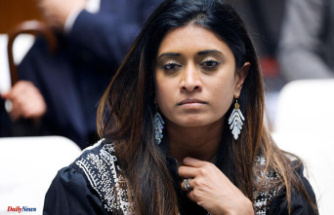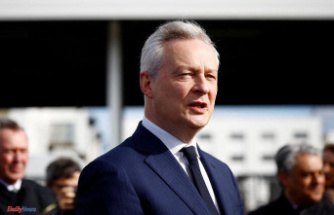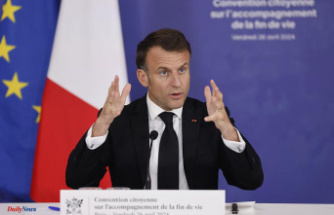The use of drones against Ukraine is part of Russia's war of attrition, says Markus Reisner, colonel in the Austrian army. In addition to the offensive at the front, Ukraine must protect its airspace. "Without this airspace protection, Ukraine cannot win the war."
ntv.de: The Iranian Shahed-136 is also known as a kamikaze drone. Does that mean it is also its own ammunition?
Markus Reisner: The Shahed-136 is a drone that basically crashes down on a programmed target like a cruise missile. It is relatively small, and that makes it very difficult for conventional anti-aircraft systems to detect it in good time and launch it. Only modern multi-sensor systems can carry out timely detection.
The drone looks like a trump card that the Kremlin is now pulling out of its pocket.
It is very easy to use. One tactic, for example, is to send in drones, which then tie up the enemy's anti-aircraft defenses. The defense system reacts, defends successfully, but then has no more missiles available for the subsequent attacks. After the drones come the cruise missiles, which can no longer be defended against and attack the target unhindered. Both sides use this tactic.
How important could air raids be for the course of the war?
In addition to what is happening tactically/operatively on the battlefield, Russia also has a strategic level that it uses against Ukraine. And this is the war of attrition, primarily through the use of cruise missiles, ballistic missiles, and now drones, against targets across Ukraine. For the Ukrainian army, this means: In addition to the offensive at the front, it must protect its airspace so that such attacks are prevented and the infrastructure is not destroyed. Without this airspace protection, Ukraine cannot win the war.
Is this problem increasing dramatically?
Russia has sharply increased the number of uses of cruise missiles, ballistic missiles and drones. In June it was 2700 according to President Zelenskyy, in August it was 3900 and now we are over 4200. The Russians apparently managed in time to replenish their weapons stores, which are already being emptied, with other weapon systems. In the medium term, Iranian missiles may be added. As a result, the Russians can continue to maintain the momentum of strategic attrition, while the Ukraine has too few modern air defense systems in particular to achieve a lasting effect here.
How do the drone attacks work?
Usually, the Russians attack in waves: about two to three times a day, and then with a whole swarm of drones at the same time. If about fifteen drones fly in, the anti-aircraft defense will shoot down maybe ten. So five still hit their target. This is devastating.
If the Shahed always destroys itself, then supplies are very important. How soon will Russia get new drones?
You can find out very easily by looking at the publicly available data from Flightradar, for example. Then you see Russian-type transport planes flying from Iran to Russia, and they will all be loaded with these drone systems. According to their own statements, the Ukrainians have shot down 243 drones in the previous waves. It can be assumed that Russia has used several hundred so far and more are available.
Russian Telegram channels are circulating the claim that Moscow will soon be manufacturing the Shahed-136 itself. Can there be something to it?
So that you have an idea - such an Iranian drone costs about 18,000-20,000 euros. In comparison: You pay half a million for a German Iris-T rocket. So a Shahed-136 is not very expensive and relatively easy to build, somewhat like a model airplane. One must not forget: Iran has been suffering from a very strict sanctions regime for years and was still able to develop this drone. Accordingly, it is certainly not a problem for Russia to start production in a relatively short time. Especially since Moscow is already using drones it developed itself, and with great success.
How can a better defense against these drones look like?
The Americans could stop these drone attacks relatively easily. All you would have to do is destroy or at least impede the Russian satellite navigation system. If that stopped working, not one of those drones or missiles would be able to hit their target because they wouldn't be receiving any data from the satellite.
That sounds perfect.
The problem with this: There are very few countries that would be able to destroy each other's satellites in space. It's the US, China has shown these skills a number of times, and Russia can do it too.
So if the drones suddenly lost their target, would Russia be aware that it couldn't have been Ukraine itself?
With that, the US would actively enter this war and cross a red line drawn by Vladimir Putin. That would set off a chain reaction from both sides involved. It would have crossed a line.
If one prefers to stay below that red line, what are the options to counter the drone attacks more effectively?
Ukraine has attempted to target the drones with what few fighter jets it has left. In one instance, however, the Shahed detonated so close to the aircraft that the fighter jet was hit by debris and crashed.
Would you rather have an anti-aircraft system?
However, this must be very modern, because the Shahed-136 is not so easy to detect. In order to ward them off, you need systems that have a whole mix of sensors available for detecting the missiles. They have optical sensors, acoustic and electromagnetic - so they recognize the drone early and can intercept it with a rocket or with machine guns, for example with the cheetah tank. This is practically the only way to destroy a drone of this size.
And you need that across the board.
The size of Ukraine is indeed a problem on this point. Unfortunately, through targeted attacks by the Russians, it has already lost many anti-aircraft systems in this war. In preparation for its counter-offensive, the Ukrainian army has attempted to pool its anti-aircraft defenses to protect deployed front-line forces from attack. In the depths of the country, she had to thin out the defense accordingly. In view of the current attacks on Kyiv and other cities, this anti-aircraft defense is missing.
What can you do?
NATO is now trying to provide support with other modern anti-aircraft systems, but given the size of the country this will of course take some time. In fact, it is also a question of available ammunition. We already talked about the drones that attack in swarms, two or three times a day. The anti-missiles are then fired off quite quickly, and the question is: will there be supplies, yes or no?
Frauke Niemeyer spoke to Markus Reisner












